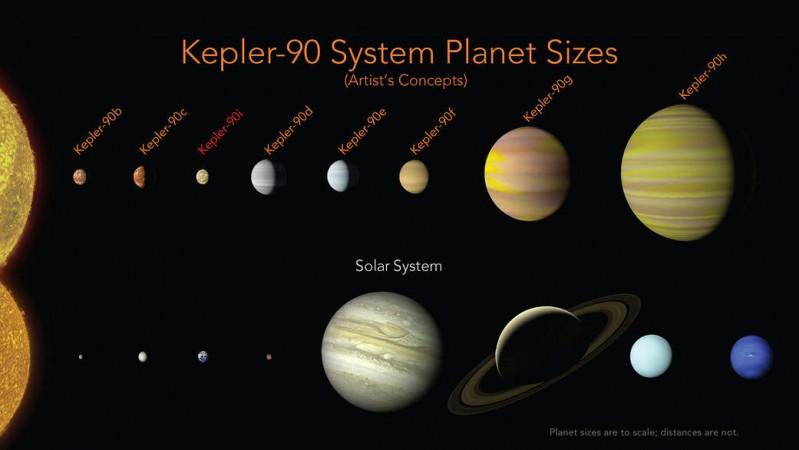With the help of artificial intelligence applied to data from NASA's Kepler Space Telescope, scientists have discovered the eighth planet orbiting Kepler-90, a Sun-like star located 2,545 light-years from Earth in the constellation Draco.
The discovery of the planet, dubbed Kepler-90i, is significant as it has helped the Kepler-90 system to tie with our solar system in a number of planets for the first time. The planet also demonstrates that other stars in the universe can host planetary systems as crowded as our own solar system.
Kepler-90i, a hot, rocky planet that orbits its star once every 14.4 days, was spotted using machine learning -- an approach to artificial intelligence in which computers "learn" -- from Google. In this case, computers mastered the techniques of identifying exoplanets by finding in Kepler data instances where the telescope recorded signals from such elusive objects outside our solar system.

"Just as we expected, there are exciting discoveries lurking in our archived Kepler data, waiting for the right tool or technology to unearth them," Paul Hertz, director of NASA's Astrophysics Division in Washington, said in a statement. "This finding shows that our data will be a treasure trove available to innovative researchers for years to come."
As part of the new research, accepted for publication in The Astronomical Journal, the researchers trained a computer to identify even a tiny change in brightness recorded by Kepler when a planet passed in front of, or transit, a star.
The artificial "neural network," used in the research, was inspired by the way neurons connect in the human brain, researchers said, adding that the latest discovery proves the ability of machine learning in the hunt for some of the weakest signals of distant worlds.
A mini solar system
Kepler-90i, which is about 30 percent larger than the Earth, is the third planet from its Sun with an average surface temperature exceeding 800 degrees Fahrenheit. The other two smaller planets within its orbit -- Kepler-90b and Kepler-90c -- revolve around Kepler-90 every seven and nine days, respectively.
The next three planets in the Kepler-90 system are Kepler-90d, Kepler-90e and Kepler-90f. They fall into a sub-Neptune size class and orbit their star every 60, 92 and 125 days, respectively.
The last two planets, Kepler-90g and Kepler-90h, are Jupiter-class gas giants which take 211 and 332 days, respectively, to circle their parent star. According to scientists, the system's outermost planet orbits at a similar distance to Kepler-90 as the Earth does to the Sun.
"The Kepler-90 star system is like a mini version of our solar system. You have small planets inside and big planets outside, but everything is scrunched in much closer," Andrew Vanderburg, an astronomer at the University of Texas at Austin, said in the statement.

AI is the key
Although the Kepler-90 system seems to echo our own, it still may not host life. Scientists also believe that other planetary systems probably hold more promise for life than Kepler-90, and machine learning can play a pivotal role in revealing these secrets.
According to scientists, Kepler's four-year dataset consists of 35,000 possible planetary signals, the weakest ones of which can be missed by both automated and human-involved tests. This is where the prowess of AI comes into play.
"Machine learning really shines in situations where there is so much data that humans can't search it for themselves," said Christopher Shallue, a senior software engineer with Google's research team Google AI, who came up with the idea to apply a neural network to Kepler data.
Shallue and Vanderburg said that their next plan was to apply the neural network to Kepler's full set of over 150,000 stars.







![India Auto Roundup: Maruti Suzuki, Mahindra have exciting launches in November [details here]](https://data1.ibtimes.co.in/en/full/805520/india-auto-roundup-maruti-suzuki-mahindra-have-exciting-launches-november-details-here.jpg?w=220&h=138)









